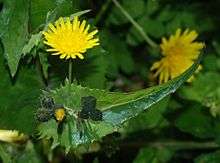Sonchus oleraceus
| Common sowthistle | |
|---|---|
 | |
| Scientific classification | |
| Kingdom: | Plantae |
| (unranked): | Angiosperms |
| (unranked): | Eudicots |
| (unranked): | Asterids |
| Order: | Asterales |
| Family: | Asteraceae |
| Tribe: | Cichorieae |
| Genus: | Sonchus |
| Species: | S. oleraceus |
| Binomial name | |
| Sonchus oleraceus L. 1753 not Wall. 1831 | |
| Synonyms[1] | |
|
Synonymy
| |
Sonchus oleraceus, with many common names including common sowthistle,[2] sow thistle,[3] smooth sow thistle, annual sow thistle, hare's colwort, hare's thistle, milky tassel, milk thistle,[4] soft thistle,[4] or swinies, is a plant in the dandelion tribe within the daisy family.
Sonchus oleraceus is native to Europe and western Asia.
The Latin name Sonchus refers to the hollow stem, while oleraceus refers to its good taste.[5] The common name sow thistle refers to its attractiveness to swine, and the similarity of the leaf to younger thistle plants. The common name hare's thistle refers to its purported beneficial effects on hare and rabbits.[6]
Botanical characteristics
This plant is annual herb with a hollow, upright stem of up to 30–100 cm high.[7] Prefers full sun, and can tolerate most soil conditions. The flowers are hermaphroditic, and common pollinators include bees and flies.[8] It spreads by seeds being carried by wind or water.
This plant is considered an invasive species in many parts of the world, where it is found mostly in disturbed areas.[9][10] In Australia it is a common and widespread invasive species, with large infestations a serious problem in crops.[11]
Nutritive qualities
Leaves are eaten as salad greens or cooked like spinach. This is one of the species used in Chinese cuisine as kŭcài (苦菜; lit. bitter vegetable).[12] Blanching or boiling removes bitter flavour.
Nutritional analysis reveals 30 – 40 mg of vitamin C per 100g, 1.2% protein, 0.3% fat, 2.4% carbohydrate. Leaf dry weight analysis per 100g (likely to vary with growing conditions) shows: 45g Carbohydrate, 28g protein, 22g ash, 5.9g fibre, 4.5g fat; in all, providing 265 calories.
Minerals
Calcium: 1500 mg
Phosphorus: 500 mg
Iron: 45.6 mg
Magnesium: 0 mg
Sodium: 0 mg
Potassium: 0 mg
Zinc: 0 mg;
Vitamins
A: 35 mg
Thiamine (B1): 1.5 mg
Riboflavin (B2): 5 mg
Niacin: 5 mg
B6: 0 mg
C: 60 mg
Herbalism
Sonchus oleraceus has a variety of uses in herbalism. It also has been ascribed medicinal qualities similar to dandelion and succory.[6]
Control
This plant can often be controlled by mowing, because it does not regrow from root fragments.[10] Attempts at weed control by herbicide, to the neglect of other methods, may have led to proliferation of this species in some environments.[13]
References
| Wikimedia Commons has media related to Sonchus oleraceus. |
- ↑ The Plant List, Sonchus oleraceus (L.) L.
- ↑ "Sonchus oleraceus". Natural Resources Conservation Service PLANTS Database. USDA. Retrieved 19 November 2015.
- ↑ Sonchus oleraceus at Plants For A Future
- 1 2 International Environmental Weed Foundation, retrieved 24 December 2015
- ↑ Arthur Lee Jacobson, Seattle Tilth newsletter Weed of the Month in May 1992, Sow Thistle; Sonchus oleraceus L.
- 1 2 "A Modern Herbal | Sow-Thistles". Botanical.com. Retrieved 2014-07-12.
- ↑ Tanaka, Yoshitaka; Van Ke, Nguyen (2007). Edible Wild Plants of Vietnam: The Bountiful Garden. Thailand: Orchid Press. p. 52. ISBN 9745240893.
- ↑
- ↑ Sonchus oleraceus at Center for Aquatic and Invasive Plants
- 1 2 Sonchus oleraceus L., Asteraceae, Pacific Island Ecosystems at Risk (PIER)
- ↑ "Common sowthistle Sonchus oleraceus". Weeds Australia. Retrieved 25 September 2014.
- ↑ "Kucai". Baidu Encyclopedia (苦菜_百度百科) (in Chinese). baike.baidu.com. Retrieved 2008-02-07.
- ↑ "Management of common sowthistle | Agriculture, Fisheries & Forestry | Queensland Government". Dpi.qld.gov.au. 2012-08-16. Retrieved 2013-01-16.
External links
- Tropicos.org: photo of herbarium specimen at Missouri Botanical Garden
- Tropicos.org: line drawing from Flora of Panama
- Nature Manitoba: Annual Sow-thistle (Sonchus oleraceus) — photos, drawings, & text from Wild Plants of Winnipeg.